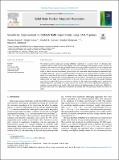Files in this item
Sensitivity improvement in 5QMAS NMR Experiments Using FAM-N Pulses
Item metadata
| dc.contributor.author | Kanwal, Nasima | |
| dc.contributor.author | Colaux, Henri | |
| dc.contributor.author | Dawson, Daniel M. | |
| dc.contributor.author | Nishyama, Yusuke | |
| dc.contributor.author | Ashbrook, Sharon E. | |
| dc.date.accessioned | 2019-03-26T11:30:17Z | |
| dc.date.available | 2019-03-26T11:30:17Z | |
| dc.date.issued | 2019-08 | |
| dc.identifier | 258124838 | |
| dc.identifier | 72c179b1-9391-4d79-8d37-3647aed32054 | |
| dc.identifier | 85063111603 | |
| dc.identifier | 000467382200001 | |
| dc.identifier.citation | Kanwal , N , Colaux , H , Dawson , D M , Nishyama , Y & Ashbrook , S E 2019 , ' Sensitivity improvement in 5QMAS NMR Experiments Using FAM-N Pulses ' , Solid State Nuclear Magnetic Resonance , vol. 100 , pp. 1-10 . https://doi.org/10.1016/j.ssnmr.2019.03.002 | en |
| dc.identifier.issn | 0926-2040 | |
| dc.identifier.other | ORCID: /0000-0002-4538-6782/work/56638943 | |
| dc.identifier.other | ORCID: /0000-0002-8110-4535/work/59464833 | |
| dc.identifier.uri | https://hdl.handle.net/10023/17370 | |
| dc.description | We would like to thank the ERC (EU FP7 Consolidator Grant 614290 “EXONMR”) and EPSRC (award of a studentship to HC through EP/K503162/1). SEA would also like to thank the Royal Society and Wolfson Foundation for a merit award. The UK 850 MHz solid-state NMR Facility used in this research was funded by EPSRC and BBSRC (contract reference PR140003), as well as the University of Warwick including via part funding through Birmingham Science City Advanced Materials Projects 1 and 2 supported by Advantage West Midlands (AWM) and the European Regional Development Fund (ERDF). Collaborative assistance from the 850 MHz Facility Manager (Dinu Iuga, University of Warwick) is acknowledged. The research data supporting this publication can be accessed at DOI: 10.17630/04b0c37f-b803-4dd7-b13a-2004b0b5c482.[49] | en |
| dc.description.abstract | The multiple-quantum magic-angle spinning (MQMAS) experiment is a popular choice for obtaining high-resolution solid-state NMR spectra of quadrupolar nuclei with half-integer spin quantum number. However, its inherently poor sensitivity limits its application in more challenging systems. In particular, the use of higher-order multiple-quantum coherences, which have the potential to provide higher resolution in the isotropic spectrum, results in a further decrease in sensitivity. Here we extend our recent work, which introduced an automated, high-throughput approach to generate amplitude-modulated composite pulses (termed FAM-N) to improve the efficiency of the conversion of three-quantum coherences, and explore the use of similar pulses in five-quantum MAS experiments. We consider three different approaches, and are able to demonstrate that all three provide good enhancements over single pulse conversion in all but the most extreme cases, and work well at a range of spinning rates. We show that FAM-N pulses are robust to variation in the quadrupolar coupling and rf nutation rate, demonstrating their applicability in multisite systems and systems where direct experimental optimisation of complex composite pulses is not feasible. This work will ease the implementation of higher-order MQMAS experiments and enable their application to materials and systems that were previously deemed to difficult to study. | |
| dc.format.extent | 10 | |
| dc.format.extent | 2557385 | |
| dc.language.iso | eng | |
| dc.relation.ispartof | Solid State Nuclear Magnetic Resonance | en |
| dc.subject | MQMAS | en |
| dc.subject | Five-quantum MAS | en |
| dc.subject | High-resolution NMR | en |
| dc.subject | Quadrupolar nuclei | en |
| dc.subject | Solid-state NMR spectroscopy | en |
| dc.subject | QD Chemistry | en |
| dc.subject | DAS | en |
| dc.subject.lcc | QD | en |
| dc.title | Sensitivity improvement in 5QMAS NMR Experiments Using FAM-N Pulses | en |
| dc.type | Journal article | en |
| dc.contributor.sponsor | The Royal Society | en |
| dc.contributor.sponsor | European Research Council | en |
| dc.contributor.institution | University of St Andrews. School of Chemistry | en |
| dc.contributor.institution | University of St Andrews. EaSTCHEM | en |
| dc.identifier.doi | https://doi.org/10.1016/j.ssnmr.2019.03.002 | |
| dc.description.status | Peer reviewed | en |
| dc.identifier.grantnumber | WM150021 | en |
| dc.identifier.grantnumber | 614290 - EXONMR | en |
This item appears in the following Collection(s)
Items in the St Andrews Research Repository are protected by copyright, with all rights reserved, unless otherwise indicated.

